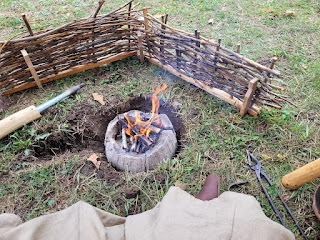Æelfwyn said she was having trouble with temperature control, hence the bubbles . The primary experiment was using Theophilus' technique of gluing the wires down with wheat paste, firing it, then adding the enamel. He used it for soldering gold wire, but it worked fine for enamel.
Friday, September 20, 2024
Æelfwyn Makes Enamel
Sunday, September 8, 2024
Stew
One of our favourite things to do as a group is eat. This was a stew with onions, beets, parsnips, carrots, lamb and herbs, made in the replica Mastermyr pot that Kettil made.
Here’s what the original looked like:
It was was 26 cm wide x 13.8 cm tall (handle not shown), found in Mastermyr, Gotland Sweden, and dated to circa 1150*. Source: The Mastermyr Find / Arwidsson & Berg, page 11, 29 - plate 11 / number 19d,
Wednesday, September 4, 2024
Weaving with an Oseberg-Style Loom
The Oseberg Ship was a rich burial from somewhere between 800 and 834, discovered in the early 1900s in Norway. It is now on display at the Viking Ship Museum in Oslo. Two women were buried in the ship, along with many textile-related items. Among the finds were parts of a loom, tablets, and a tablet-woven band.
Hrobjartr, who normally does our tablet weaving, is unable to work due to a broken arm. We wish him a full recovery before he gets replaced by young Fion, shown here making the band found at Oseberg on a reproduction loom.
Tuesday, September 3, 2024
Our Camp at “Ribe” is Closed for the Season
Thorgeir turned bowls on his pole lathe.
Jhone worked on her warp-weighted loom when she wasn’t cooking, and several visitors had fun weaving under her supervision. Herr she is chatting with Kadin, who is also a skilled textile worker.
Ælfwyn spent the day making enamelled items.
Auðr mostly puttered around the hearth, making butter, fixing some kitchen tools to be more useful, and making a new wooden spatula.
Monday, September 2, 2024
Nålbinding
It was chilly last night so Kaðlin was wise to spend much of the last two days making herself a new nålbound cap using wool she had dyed and spun herself. She is using a simple loop stitch. The pink comes from madder while the blue is indigo over dyed with weld. While indigo was not found in the Viking Norse areas, chemically it is the same as weld, which was.
Sunday, September 1, 2024
Iron
Today I happened to sit through a class on iron by Kettil (Darrell Markewitz).
He talked about sources of iron, the basic processes to extract ore and turn it into iron, softer (easier to work), vs hard (holds an edge but brittle) and how both would be incorporated into things like knives or axes.
He also talked about the quality of iron produced and showed objects to demonstrate how it was used.
The most striking figure for me (Auðr) was the average amount of iron per person in a household: 2 kg. What that meant was you would have a personal knife but not much more. A ship needed around 2000 nails. Your household would likely have an axe, maybe some metal-edged farming implements, a cooking pot, and possibly a bit more stuff like a cauldron hangar, pan or fork, depending on the size of the household. Things like fry pans and forks may have had wooden handles. A shovel would be wood with just a metal edge on the digging part.
DARC is getting more active on social media
Dear readers,
We had a hard time moving from the first millennium CE to the modern world: futhark to megBytes.
We’re on Threads and Instagram as @dark_ages_recreation_company.
You can also find us on Bluesky as https://bsky.app/profile/darc-company.bsky.social
And we’re on Facebook at The Norse Company
Thorgeir in an intense conversation over preparations for a living history presentation.
 |
Labels
- Cooking (1)
- events (39)
- experimental archaeology (16)
- glass (12)
- interpreting (4)
- iron smelting (11)
- media review (1)
- object (6)
- public presentations (23)
- research (3)
- textile (4)
- travel tales (19)
- Viking Age (27)
- Vinland (37)
DARC Links
DARC Calendar
| Date | Event |
|---|---|
| May 2-4, 2019 | EAC 11, Trento, IT* |
| May 9-12, 2019 | EXARC Session at ICMS, Kalamazoo, MI |
| May ??, 2019 | Open Workshop* |
| Jun 8-10, 2019 | Upper Canada Village Medieval Faire Presentation |
| Jun 29, 2019 | Smelt |
| Jul ??, 2019 | Bead Burn* |
| Aug ??, 2019 | Bead Burn* |
| Sep 6-8, 2019 | Althing (SCA Event) |
| Sep 15, 2019 | CAMELOT, Waterloo, ON |
| Oct 5, 2019 | Bogenschutzenfest, Kitchener, ON |
| Oct 12, 2019 | Smelt |
| Oct 25-26, 2019 | REARC, Williamsburg, VA |
| Nov 2, 2019 | Smelt |
| * | tentative |
Contributors
- Darrell Markewitz
- Karen Peterson
- Neil Peterson
- Vandy Simpson
- Contact Us: info@darkcompany.ca
















